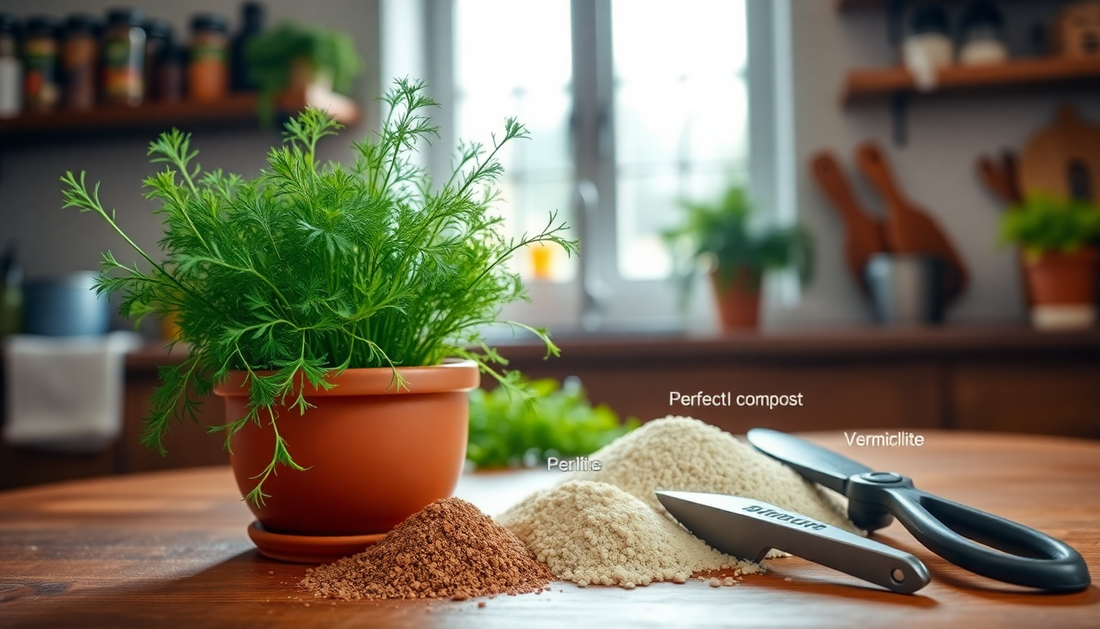
Cultivating Dill Indoors: Crafting the Perfect Soil Blend
As the sun streams through the window, casting a warm glow on your indoor garden, the delicate fronds of your dill plants sway gently. Dill, with its distinctive flavor and aroma, is a beloved herb that can thrive indoors, provided you give it the right growing conditions. One of the most crucial elements in ensuring your dill's success is the soil blend you choose.
At Idyl, our online gardening shop in Bangalore, we've helped countless customers create the perfect soil mix for their indoor dill plants. In this comprehensive guide, we'll share our expertise and walk you through the steps to crafting a nutrient-rich, well-draining potting mix that will set your dill up for success.
Understanding the Dill Plant's Soil Needs
Dill, a member of the Apiaceae family, is a hardy herb that thrives in well-draining, nutrient-rich soil. In its natural habitat, dill grows best in loose, loamy soil with a slightly acidic pH. When growing dill indoors, it's essential to mimic these conditions to ensure your plants flourish.
Drainage and Aeration
Dill plants are susceptible to root rot if the soil remains too moist for too long. To prevent this, the soil must have excellent drainage and aeration, allowing excess water to quickly flow out while still retaining enough moisture to keep the roots hydrated.
Nutrient Content
Dill is a heavy feeder, requiring a steady supply of essential nutrients to support its growth and development. The soil blend should be rich in organic matter, providing a steady release of nitrogen, phosphorus, and potassium, as well as other micronutrients.
pH Balance
Dill prefers a slightly acidic soil pH, typically between 6.0 and 7.0. This pH range ensures the plant can efficiently absorb the necessary nutrients from the soil.
Crafting the Perfect Soil Blend
Now that we've established the key requirements for dill's soil, let's dive into the step-by-step process of creating the perfect potting mix for your indoor dill plants.
Ingredients
To create a well-balanced, nutrient-rich soil blend for your dill, you'll need the following ingredients:
-
Compost: This is the foundation of your soil mix, providing essential organic matter and a wide range of nutrients. Look for a high-quality, well-decomposed compost.
-
Perlite or Vermiculite: These lightweight, porous materials help improve soil drainage and aeration, preventing waterlogging.
-
Peat Moss or Coco Coir: These materials help retain moisture while also improving soil structure and drainage.
-
Slow-Release Fertilizer: Incorporate a slow-release, balanced fertilizer to provide a steady supply of nutrients for your dill plants.
-
Dolomitic Lime: This helps adjust the soil pH to the slightly acidic range preferred by dill.
Mixing the Soil Blend
-
Measure the Ingredients: Start by measuring out the following proportions: 50% compost, 20% perlite or vermiculite, 20% peat moss or coco coir, 5% slow-release fertilizer, and 5% dolomitic lime.
-
Combine the Ingredients: In a large container or on a clean surface, mix the ingredients thoroughly until you have a uniform, well-blended potting mix.
-
Test the pH: Use a soil pH test kit to ensure the blend is within the ideal range of 6.0 to 7.0. If the pH is too high, add more dolomitic lime; if it's too low, incorporate some limestone.
-
Sterilize the Soil: To prevent the introduction of pests or diseases, it's a good idea to sterilize the soil blend before using it. You can do this by baking the mixture in the oven at 200°F (93°C) for 30 minutes.
-
Allow to Cool: Once the soil has been sterilized, let it cool completely before using it to plant your dill.
Planting and Maintaining Dill in the Perfect Soil
With your custom-blended, nutrient-rich soil ready, it's time to plant your dill and provide the necessary care to ensure it thrives.
Planting Dill
-
Choose a well-draining container or pot with ample drainage holes. Dill has a deep taproot, so a container at least 12 inches (30 cm) deep is recommended.
-
Fill the container with your prepared soil blend, leaving a few inches of space at the top.
-
Sow the dill seeds about 1/4 inch (6 mm) deep, spacing them 6 to 8 inches (15 to 20 cm) apart.
-
Gently water the soil, taking care not to displace the seeds.
Caring for Dill
-
Watering: Keep the soil consistently moist, but not waterlogged. Check the soil daily and water when the top inch (2.5 cm) feels dry to the touch.
-
Sunlight: Dill thrives in full sun, so place your container in a spot that receives at least 6 hours of direct sunlight per day.
-
Fertilizing: Every 4 to 6 weeks, apply a diluted, balanced liquid fertilizer to replenish the nutrients in the soil.
-
Harvesting: Snip the dill leaves as needed, taking care not to remove more than a third of the plant at a time.
By following these steps and using the custom soil blend we've outlined, you'll be well on your way to growing a thriving, flavorful crop of dill in the comfort of your own home. Remember, the key to success lies in providing your dill plants with the perfect growing medium and the right care.
Happy gardening!







No comments